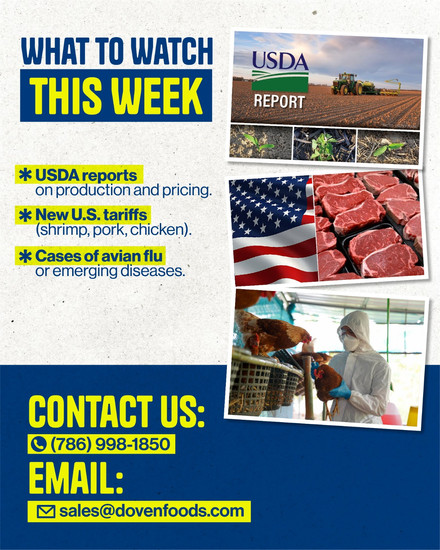Doven Foods Market Pulse - Tuesday, June 3, 2025
- Alicia Diaz
- Jun 3
- 3 min read
Welcome to this week’s Doven Foods Market Pulse, your essential read on global protein markets.
Global Outlook
Global protein markets remain tight, with demand outpacing supply. The USDA reports that U.S. red meat production at the end of May was approximately 5% lower than a year ago, reflecting herd reductions due to drought and the impact of holidays. Beef cutout values remain high (Choice ~USD 360/cwt) as packers process existing inventory. Freight rates have generally stabilized: DHL’s report shows maritime transport costs leveling off (though down on transpacific routes). Trade uncertainty persists: Latin America’s growth was cut to ~2% for 2025, and U.S. tariff policy remains unpredictable.
Category Insights
Functional and Value-Added Proteins
Innovation in alternative and functional proteins continues to grow. Companies are launching new hybrid-based foods as consumers seek high-protein, clean-label ingredients. The rise in protein snacks, bars, and supplements remains strong, boosting demand for protein isolates and concentrates. Overall, health and sustainability trends are fueling the boom in value-added proteins, making it an expanding investment area.
Beef (Middle cuts, rounds, chucks, ground)
U.S. cattle supplies are extremely tight. The USDA reports weekly beef production as of May 31 fell sharply (~16% week-over-week), keeping cut prices high. Cattle inventories are at historic lows, which has sustained elevated beef cutout values (~USD 360/cwt for Choice). The “tight cattle supply and strong consumer demand” are keeping beef prices elevated. In fact, ground beef hit record levels: in April, lean ground beef surpassed ~$6.00/lb on U.S. store shelves. Middle Meats (ribs, loins) are increasing in price heading into summer.
Pork (Loins, legs, ribs, offal, shoulders, belly)
U.S. pork is well supplied and remains a good value for both retail and foodservice. Domestic and international demand is strong; in fact, the U.S. has “filled the gap” left by Europe’s halted export supply due to FMD. Seasonal cuts (loin, picnics, hams) remain firm with summer demand, while belly (for bacon) is trading at mid-range levels.
Poultry (Thighs, boneless breasts, wings, MSC, turkey)
Chicken demand remains strong, though prices are high. With breast prices rising, retailers are highlighting thighs and drumsticks (demand for dark meat is up), while wings are the only cut softening. Despite global avian flu, local chicken supply is ample. Turkey inventory is low (due to reduced flocks), pushing prices upward. Chicken continues to be the most affordable protein in the U.S., especially with beef at record highs.
Seafood (Shrimp, tuna, octopus, squid, salmon, others)
Shrimp inventories are ample and wholesale prices have held steady after the holiday weekend. Tuna markets at origin are declining: Skipjack and Yellowfin prices continue to fall due to abundant catches and cautious demand. However, new U.S. import tariffs remain uncertain and are keeping prices in limbo. For farmed salmon, prices are mixed: Norwegian prices are down, Scottish prices are stable, and Chile’s larger harvest is increasing supply. Cephalopods are very tight: the FAO reports global octopus and squid supply is constrained, pushing prices to the highest levels in years.
Latin America & Caribbean Outlook (Focus on DR)
Dominican Republic – Protein production is a standout case. The country’s poultry sector is expanding and meeting much of the internal demand, except for the hotel segment. Domestic inflation has risen (~3.6% year-over-year as of March), and the central bank is monitoring closely.
Other LatAm/Caribbean Markets – Overall, regional demand faces challenges: economic growth is slow (~2% according to ECLAC), and currencies have been volatile. Many countries remain net protein importers; any logistical disruption (e.g., Panama Canal congestion or fuel price spikes) or shifts in U.S. trade policy can quickly impact their costs. Brazil’s export policies (e.g., poultry to Mexico/Asia) and Mexico’s tariff stance continue to influence regional meat flows.
What to Watch This Week
USDA Reports – Upcoming USDA reports (weekly slaughter, beef cutout values) will show whether production rebounds after May’s dip. Sharp increases or declines could set short-term price trends.
U.S.–Mexico Cattle Talks – A USDA mission is inspecting Mexican herds to monitor screwworm. If Mexico remains free of the pest, U.S. cattle imports could continue through year-end, easing local supply.
Tariff Decisions – Watch for new U.S. rulings on imports (e.g., shrimp tariffs in July and possible changes for chicken/pork). New duties or sanctions could shift trade flows, especially from Asia and Latin America.
Disease Developments – Monitor new H5N1 avian flu cases in poultry or dairy cattle (CDC has reported recent detections in the U.S.).
Key Takeaways
Supply remains tight for beef and chicken breast; demand for value-added proteins continues to grow.
Pork offers pricing stability despite belly volatility.
Shrimp may present a buying opportunity; squid and octopus remain expensive.
This weekly report has been prepared by the Doven Foods Research Team.













Comments